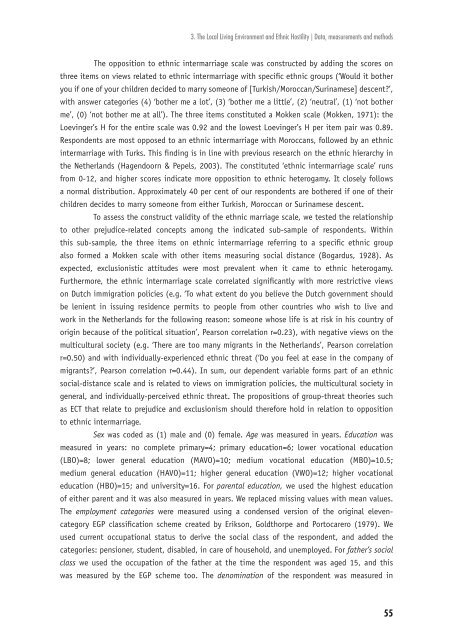Ethnic Hostility among Ethnic Majority and Minority Groups
Ethnic Hostility among Ethnic Majority and Minority Groups
Ethnic Hostility among Ethnic Majority and Minority Groups
You also want an ePaper? Increase the reach of your titles
YUMPU automatically turns print PDFs into web optimized ePapers that Google loves.
3. The Local Living Environment <strong>and</strong> <strong>Ethnic</strong> <strong>Hostility</strong> | Data, measurements <strong>and</strong> methods<br />
The opposition to ethnic intermarriage scale was constructed by adding the scores on<br />
three items on views related to ethnic intermarriage with specifi c ethnic groups (‘Would it bother<br />
you if one of your children decided to marry someone of [Turkish/Moroccan/Surinamese] descent?’,<br />
with answer categories (4) ‘bother me a lot’, (3) ‘bother me a little’, (2) ‘neutral’, (1) ‘not bother<br />
me’, (0) ‘not bother me at all’). The three items constituted a Mokken scale (Mokken, 1971): the<br />
Loevinger’s H for the entire scale was 0.92 <strong>and</strong> the lowest Loevinger’s H per item pair was 0.89.<br />
Respondents are most opposed to an ethnic intermarriage with Moroccans, followed by an ethnic<br />
intermarriage with Turks. This fi nding is in line with previous research on the ethnic hierarchy in<br />
the Netherl<strong>and</strong>s (Hagendoorn & Pepels, 2003). The constituted ‘ethnic intermarriage scale’ runs<br />
from 0-12, <strong>and</strong> higher scores indicate more opposition to ethnic heterogamy. It closely follows<br />
a normal distribution. Approximately 40 per cent of our respondents are bothered if one of their<br />
children decides to marry someone from either Turkish, Moroccan or Surinamese descent.<br />
To assess the construct validity of the ethnic marriage scale, we tested the relationship<br />
to other prejudice-related concepts <strong>among</strong> the indicated sub-sample of respondents. Within<br />
this sub-sample, the three items on ethnic intermarriage referring to a specifi c ethnic group<br />
also formed a Mokken scale with other items measuring social distance (Bogardus, 1928). As<br />
expected, exclusionistic attitudes were most prevalent when it came to ethnic heterogamy.<br />
Furthermore, the ethnic intermarriage scale correlated signifi cantly with more restrictive views<br />
on Dutch immigration policies (e.g. ‘To what extent do you believe the Dutch government should<br />
be lenient in issuing residence permits to people from other countries who wish to live <strong>and</strong><br />
work in the Netherl<strong>and</strong>s for the following reason: someone whose life is at risk in his country of<br />
origin because of the political situation’, Pearson correlation r=0.23), with negative views on the<br />
multicultural society (e.g. ‘There are too many migrants in the Netherl<strong>and</strong>s’, Pearson correlation<br />
r=0.50) <strong>and</strong> with individually-experienced ethnic threat (‘Do you feel at ease in the company of<br />
migrants?’, Pearson correlation r=0.44). In sum, our dependent variable forms part of an ethnic<br />
social-distance scale <strong>and</strong> is related to views on immigration policies, the multicultural society in<br />
general, <strong>and</strong> individually-perceived ethnic threat. The propositions of group-threat theories such<br />
as ECT that relate to prejudice <strong>and</strong> exclusionism should therefore hold in relation to opposition<br />
to ethnic intermarriage.<br />
Sex was coded as (1) male <strong>and</strong> (0) female. Age was measured in years. Education was<br />
measured in years: no complete primary=4; primary education=6; lower vocational education<br />
(LBO)=8; lower general education (MAVO)=10; medium vocational education (MBO)=10.5;<br />
medium general education (HAVO)=11; higher general education (VWO)=12; higher vocational<br />
education (HBO)=15; <strong>and</strong> university=16. For parental education, we used the highest education<br />
of either parent <strong>and</strong> it was also measured in years. We replaced missing values with mean values.<br />
The employment categories were measured using a condensed version of the original elevencategory<br />
EGP classifi cation scheme created by Erikson, Goldthorpe <strong>and</strong> Portocarero (1979). We<br />
used current occupational status to derive the social class of the respondent, <strong>and</strong> added the<br />
categories: pensioner, student, disabled, in care of household, <strong>and</strong> unemployed. For father’s social<br />
class we used the occupation of the father at the time the respondent was aged 15, <strong>and</strong> this<br />
was measured by the EGP scheme too. The denomination of the respondent was measured in<br />
55












